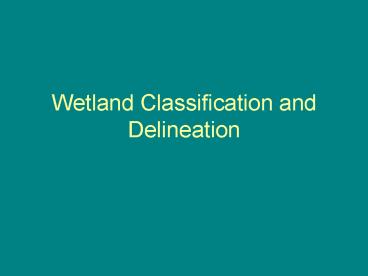Wetland Classification and Delineation - PowerPoint PPT Presentation
1 / 37
Title:
Wetland Classification and Delineation
Description:
Wetlands are delineated primary so that property owners will know which parts of ... Emphasis on cropped wetlands. Wetlands Reserve Program (WRP) ... – PowerPoint PPT presentation
Number of Views:159
Avg rating:3.0/5.0
Title: Wetland Classification and Delineation
1
Wetland Classification and Delineation
2
Nathaniel Shaler, General Account of the
Freshwater Morasses of the United States(USGS,
1890)
3
all areas in which the natural declivity is
insufficient, when the forest cover is removed,
to reduce the soil to the measure of dryness
necessary for agriculture
4
Wetlands are delineated primary so that property
owners will know which parts of their land could
be fall under federal regulatory jurisdiction
5
Wetlands fall under federal jurisdiction as a
result of the Clean Water Act and the Food
Security Act of 1985
6
Clean Water Act
- 1972,1977
- Section 404 established a permit sytem for the
discharge of dredged or fill materials into
navigable waters - Term wetlands was not used in the Act
- Initial permitting given to the USACE, later
shared with USEPA
7
Food Security Act
- Introduced in 1985, amended in 1990
- Established two conservation programs for the
protection of wetlands - Doesnt prohibit filling, offers incentives and
penalties to protect wetlands - NRCS does delineation
8
Swampbuster in the Food Security Act
- Conservation Reserve Program (CRP)
- Emphasis on cropped wetlands
- Wetlands Reserve Program (WRP)
- Tries to provide incentives to protect, preserve,
and enhance wetlands - WRP offers options of permanent easements,
30-year easements and 10 year restoration cost
share agreements
9
The SWANCC Decision
- January 9, 2001
- Solid Waste District of Northern Cook County
(SWANCC) v. United States Army Corps of Engineers
10
(No Transcript)
11
(No Transcript)
12
Fish and Wildlife Service Circular 39
13
- 1956
- Emphasized wetlands that were important waterfowl
habitats - Listed 20 types of wetlands
14
CLASSIFICATION OF WETLANDS AND DEEPWATER
HABITATSOF THE UNITED STATES
15
Marshes, swamps, and bogs have been well-known
terms for centuries, but only relatively recently
have attempts been made to group these landscape
units under the single term "wetlands."
16
There is no single, correct, indisputable,
ecologically sound definition for wetlands,
primarily because of the diversity of wetlands
and because the demarcation between dry and wet
environments lies along a continuum.
17
(No Transcript)
18
(No Transcript)
19
(No Transcript)
20
(No Transcript)
21
(No Transcript)
22
(No Transcript)
23
The Cowardin System
- Released in 1979
- FWS report
- Introduced concept of hydrophytes and hydric
soils - Concept of predominance
- Introduced the use of the three factors
hydrology, soils and vegetation
24
Defines Five Major Systems
- Marine
- Estuarine
- Riverine
- Lacustrine
- Palustrine
25
Before 1986 none of the federal agencies with
regulatory powers had adopted a uniform technical
manual or formal rules for delineation
26
In the 1980s each agency adopted their own
delineation manual
27
In the late 1980s all of the agencies worked
together to create the 1989 interagency manual,
which was designed to insure consistent
regulation of wetlands
28
The 1989 Interagency Manual
29
Hydrogeomorphic Classification
30
HGM Classification is Based on Three Principles
31
1. Uses Four Types of Information for initial
clasification
- Geomorphic setting
- Water source and transport vector
- Hydrodynamics
- Water chemistry and soil properties
32
2. Reference Wetlands
- Use of a set of wetlands that represents wetlands
of a region or "domain" regardless of their
condition - Should be sites where parameters can be or have
been measured, and should be representative of
all degrees of disturbances that occur to wetland
ecosystems
33
3. Collection of Data
- The third principle of HGM approach is the
rigorous collection of data from reference
wetlands that can be used to scale variable
conditions and develop functional indices.
34
The Convention on Wetlands of International
Importance especially as Waterfowl Habitat
Ramsar
35
- International conference held in Ramsar, Iran
(1971) - "areas of marsh, fen, peatland or water, whether
natural or artificial, permanent or temporary,
with water that is static or flowing, fresh,
brackish or salt, including areas of marine water
the depth of which at low tide does not exceed
six metres".
36
(No Transcript)
37
The Canadian Wetland Classification
SystemNational Wetlands Working Group. 1987































